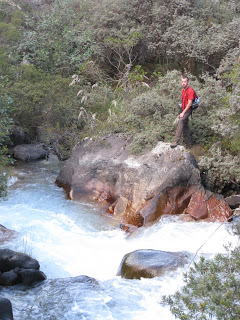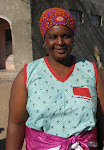This post now a Google News Link and on www.basilandspice.com.
Chacma baboons on the road outside Skukusa in Kruger National Park, South Africa. Photo by Sally Kneidel, PhD
To me, monkeys and apes bridge the gap from animal to human. Their behavior is in many ways similar to ours, but it seems so unhampered by civility. I love them for that. In my view, they represent our own animal nature.
I fell in love with chimps in grad school, trying to teach them American Sign Language. But the chimps really did scare me. They have big teeth too. And just like human teenagers, chimps will test authority when forced to sit for lessons. They tested me during the language sessions, "accidentally" running into me and trying to bite me, sometimes succeeding. (See my previous post about the chimps and ASL.) I gave up on teaching chimps to behave like humans, and fled to the relative simplicity of studying salamanders in the field.
But I never lost my fascination with primates. This past summer I had the joy of 4 weeks in South Africa, where we saw several primate species - vervet monkeys, lesser bushbabies, thick-tailed bushbabies, and most of all, Chacma baboons.
An adult Chacma baboon, with its long doglike face. Photo by Sally Kneidel, PhD
Baboons are the most widespread primate in Africa.
The range of some baboon species has even expanded, in spite of widespread deforestation, overgrazing, and habitat destruction. The range expansion is due to the local extinction of their predators (especially leopards),
Leopard in South Africa. Photo by Sally Kneidel, PhD
and because baboons are so adaptable in their eating habits. Chacmas can forage equally well on trees or grasses, on farmland or savannas, can get most of the water they need from their food.
A young baboon eating leaves. Photo by Sally Kneidel, PhD
Young baboons eating sausage fruits that fall from trees in southern Africa. Photo by Sally Kneidel, PhD
Chacma baboons can even dig shallow wells in dry streambeds, which most animals don't do. When grasses are dry, baboons just dig up the juicier roots. They will eat almost any small animal they can catch, from fish and bird eggs to young antelope. In South Africa, Chacma baboons are a major predator of young goats and sheep.
I said that primate behavior is unhampered, but that's not really true. According to biologist Richard D. Estes, a baboon troop is one of the most complex societies in the animal kingdom. And complexity means structure. Females and their offspring are the core of the troop, with females outnumbering males 2 or 3 to 1. The female Chacmas spend their whole lives in the troop where they were born, where they compete to attain and maintain dominance. Female rank-order is family-based: daughters inherit their mother's rank.
A female Chacma baboon with her infant and two youngsters. The older ones may be her own, or they may be others just interested in holding her baby. Photo by Sally Kneidel, PhD
Baboons' matrilineal society is complicated
Dominance relationships between matrilines are managed by alliances and by communication that's nearly as complex as that of the great apes, according to Dr. Estes.(A matriline is a line of females linked by maternal descent.)
Males in the troop are subordinate to their mothers until the age of four, when their dangerous fangs develop and they leave the troop. The males may try out several troops before settling in one, at least temporarily. Males grow much larger than females, and can weigh as much as 100 lbs. The upper limit of female weight is about 60 lbs.
A male Chacma baboon displays his genitals as a signal of his maturity and social rank or dominance. Photo by Sally Kneidel, PhD
Males play "godfather" roles
After transferring to a new troop, a male is better off if he cultivates a social bond with a mature female. Estes says that a male may play a "godfather" role to her offspring, even though he is not their father. He holds and carries them, shares food with them, grooms them. Social grooming is a major pastime for baboons, and a major bonding activity.
Social grooming of the head is common.The recipient above seems to enjoy it! Photo by Sally Kneidel, PhD
Grooming of the hind-end is common too. I think they're looking for fleas and ticks, but I'm not sure. Photo by Sally Kneidel, PhD
A male "godfather" will also protect his female friend from attack and protect her young from bullies. So lots of Chacma females have one to three male friends that they roost with at night. (Chacmas generally roost in trees, where they're safer from predators.) When the female comes into estrus, one or more of these favorites, or "godfathers", usually becomes her consort.
During estrus, the sexual skin of a female is swollen and pink, as in the female at right, above. The degree of swelling and redness signals how close she is to ovulation. Photo by Sally Kneidel, PhD
Low-ranking females especially benefit from having male friends to protect their babies. All Chacma baboons are attracted to black-haired infants and a dominant female can hold and play with the infant of a subordinate mother, regardless of how much distress it causes the mom or the infant. But a male "godfather" will put an end to that, even though the youngster is not his own offspring. The males' larger size, and their fangs, make them excellent defenders.
Above, a newborn infant, with the black hair that all Chacmas find so attractive in infants. Photo by Sally Kneidel, PhD
Above, a Cape Chacma mother nursing her black-haired infant, with her older youngster alongside. The Cape Chacma baboons are a different subspecies found only at the southern tip of Africa. It's thought that the isolated population of Cape Chacmas will be extinct in 10 years. Photo by Sally Kneidel, PhD
The same mother grooming her older offspring, with her black-haired infant clinging to its sibling. Photo by Sally Kneidel, PhD
Almost all primates are now in danger The same mother grooming her older offspring, with her black-haired infant clinging to its sibling. Photo by Sally Kneidel, PhD
A black-haired infant is such a powerful attractant for Chacma baboons that "a lower-ranking male can safely threaten and even dominate a higher-ranking one by holding out a black infant - it completely inhibits the others's attack tendencies." So writes Richared Estes in his very useful book, The Safari Companion: A Guide to Watching African Mammals. Estes is a research associate of the Smithsonian Institute, an associate of the Harvard Museum of Natural History, and co-chairman of the World Conservation Unions's Antelope Specialists Group.
Virtually all the world's primates now are threatened by loss of habitat, by capture for the pet trade, for research labs, and for traditional medicines. Snaring or shooting primates and other species for bushmeat is a growing problem in impoverished areas. Most primates live short lives; very few die of old age. The Chacma is considered to be potentially threatened under C.I.T.E.S Appendix 2, if populations are not managed.
Some Chacma baboon troops forage in human neighborhoods, overturning garbage cans and entering homes looking for food. When food is in question, baboons can be aggressive and dangerous. And when they become pests to families, farmers, or herders, baboons and other wildlife are often poisoned.
A young baboon foraging in northern Kruger National Park, South Africa. Photo by Sally Kneidel, PhD
What can you do?
When visiting an area with primates, never feed them, even if you see others doing so. Feeding them endangers their health and the safety of the entire troop. Baboons that associate humans with food can behave so aggressively that they're likely to be killed. Consider making donations to conservation organizations that protect habitat or protect primates directly, such as the Jane Goodall Institute, Traffic, World Wildlife Fund, African Conservation Foundation, and Conservation International. Or support impoverished communities in areas where primates live. People with other opportunities to support their families are less likely to snare and sell wildlife.
Sources:
Richard D. Estes. The Safari Companion: A Guide to Watching African Mammals.1997.
Bill Branch et al. Travellers' Wildlife Guides: Southern Africa. 2007.
My previous posts about wild, enchanting Africa: wildlife, indigenous villages, health, climate change, and ecotourism:
Famous ice caps of Kilimanjaro gone by 2022. 12/17/2009
Budding scientists assess the tiny critters of Africa 11/11/2009
New studies confirm that circumcision saves lives in Africa 10/28/2009
My visit to a traditional healer in Africa: "Call on your female ancestors" 9/28/2009
Seeing myself....in the eyes of a monkey 9/8/2009
A sustainable, locally run, and off-the-grid resort in South Africa; great for birding 8/26/2009
With a chain-saw, he cut off the rhino's valuable horn 8/15/2009
Leopard adventure: male and female clash over prey 8/4/2009
We were lucky to see lions on a kill. But are lions disappearing from Africa? 7/30/2009
In the Africa village of Hamakuya, we learned about life with limited resources. 7/24/2009
Female hyenas, all hermaphrodites, bully male hyenas and steal prey from lions. 7/17/2009
African village of Welverdiend believes in the power of good. 7/10/2009
Pope values religious dogma over African lives? 3/18/2009
Ecotourism can buffer the effects of poverty. 10/20/2008
Can a warmer planet feed us? 6/14/2008
Environmental footprints of rich nations outweigh debt 3/21/08
Violence in Darfur fueled by global warming. 11/2007
Breastfeeding gets a new review in sub-Saharan Africa. 10/25/2007
An African village seeking solutions. 8/26/2007
Plan to spend a day in the African village of Welverdiend 8/6/2007
The luminous, magical continent. 7/19/2007
Back from Africa; elephants may be culled. 7/13/2007
One African family struggles to survive 3/17/2007
Key words:: Chacma baboons primates South Africa Kruger National Park loss of habitat endangered threatened impoverished communities conservation pet trade research trade poisoning bushmeat traditional medicine

































